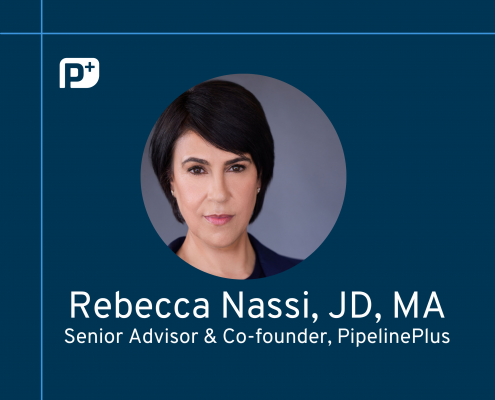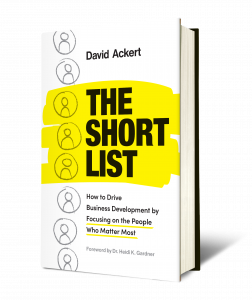Competition today is fiercer than ever as professional services firms increase their investments in the technologies that can help them attract, target, and acquire new business. Firm leaders who used to view client development as a function reserved for rainmakers look for ways to leverage contributions more broadly across the firm, and marketers work hard to keep up with increasing demands. But one thing hasn’t changed: seller-doers such as lawyers, accountants, financial advisors, and consultants continue to resist the idea of “selling.”
Addressing the dissonance between the firm’s strategic goals and the individual seller-doer’s desires requires a culture change that can be difficult to engender without external resources. Marketers and business developers should consider implementing a battle-tested solution adopted by over 70% of US firms: a business development training and coaching program.
Why Combine Business Development Training and Coaching?
The distinction between training and coaching is a simple one. Training is an educational process that teaches new information, best practices, and techniques. It is a one-way flow of information typically delivered through lectures, e-learning, or written materials.
Coaching is an interactive process that encourages the participant to explore new ideas, air out concerns, and practice their techniques, so they are better prepared to succeed when it comes time to apply what they’ve learned.
Together, training and coaching become a powerful combination for teaching the nuanced soft skills and discipline required to develop and expand a sophisticated, sustainable client base.
The Five Elements of a BD Training and Coaching Initiative
Successful business development training and coaching initiatives include the following five elements:
#1. Plan
Tie the initiative to your firm’s strategic plan to gain buy-in from participants and leadership. This will help you make a business case for budget approval.
#2. Train
Educate your participants using multi-modal training formats to maximize retention across visual, auditory, kinesthetic, and reading/writing learning styles.
#3. Implement
Supply regular individual and/or group coaching to reinforce training principles, support engagement, and encourage accountability.
#4. Track
Use technology like PipelinePlus or CRM to track business development activity, originations, and ROI on the initiative.
#5. Outsource
If your department is under-resourced, engage service providers to reduce the burden on your bandwidth, increase efficiency, and deliver better ROI.
Planning a Business Development Training and Coaching Initiative
How to Obtain Buy-In
In traditional sales terms, if your product is a business development coaching program and your prospects are busy service professionals, you won’t be able to close them on taking part if you don’t address their objections. And most are reluctant to engage in anything that might distract them from billable work unless their self-preservation depends on it.
As any good salesperson will tell you, when your prospects show reluctance to buy, you must be able to counter their objections effectively. Here are the top four most common objections you will encounter and how to respond to them.
“I don’t have time.”
By far the most prevalent complaint, this objection is certainly understandable. Fortunately, you can alleviate much of this burden by managing the organizational and administrative tasks involved.
Schedule monthly meetings with each participant to review their pipelines. Help them keep track of prospects using a simple pipeline management system such as PipelinePlus.
Ask them to send emails, make calls, and schedule lunches with prospects when possible, during the coaching meeting while you have a captive audience. Focus on activities that are easy to implement, rather than time-intensive endeavors like article-writing. After the meeting with each participant, update their pipeline with new activities and notes so you can follow up on their progress.
“I have enough work on my plate. I don’t need more.”
Most service professionals are in some degree of denial about their future at the firm. The fact is that unless they make business development a priority early in their careers, they will find themselves bumping up against a glass ceiling when the topic of equity partnership comes due.
Frame this conversation in terms of career enhancement. Maybe they don’t want to become rainmakers, in which case they can forgo business development altogether, but a book of business is the price of admission for influence.
“I don’t know where to start.”
This is another valid consideration among busy service professionals. After all, they weren’t taught sales in school. However, many erroneously believe that business development requires casting a wide net, pursuing an excessive number of opportunities, and trying to broker deals with disinterested or unwilling people.
This is certainly not the case. Filling a pipeline with too many tenuous opportunities is not only time-consuming and stressful but also ineffective. To address this concern, ask them to identify five clients, five prospects, and five referral sources from whom they are most likely to obtain new business. Strengthening these 15 relationships is not only manageable; it leads to authentic dialogues during which they can assess their contacts’ needs.
“I think selling is sleazy.”
You probably won’t be able to get your subjects to voice this concern out loud, but it’s likely they have some level of discomfort with the idea of business development if they show ongoing reluctance. The three methods above will work with those who are at least willing to try, but for the rest, there needs to be a sea change in the way they perceive business development.
The very word “sales” is taboo at some firms because it evokes ideas of pushy sales reps who will say anything to close a deal, even if it’s not in their prospect’s best interests. And if your industry can’t even use the word “sales” without flinching, it’s no wonder your business developers are reluctant to dedicate time to it.
To be effective, they need to believe in what they are selling and go into their pitch with the intent of helping. If they learn to think about their clients, prospects, and referral sources as friends rather than targets, they start to understand that selling is nothing more than another act of service with a potential beneficiary.
Key Principles of Business Development Training in Professional Services Firms
Motivated candidates
Participant selection is one of the primary driving factors of success in any business development initiative. Invest in professionals who have shown an appetite for business development by positioning the program as a privilege.
Initiate the selection process with an application process that examines your trainees’ motivations for wanting to join the program and what they intend to achieve. Be sure to pilot with early adopters rather than offer a firm-wide program right out of the gate. Once the pilot group has gained traction, their peers will be more likely to participate. Group participants according to their seniority level so that peer-to-peer discussion is relevant for everyone involved.
Time-efficient materials
Even the most enthusiastic professionals will balk if the training materials require too significant a time investment. Assemble a curriculum that requires a manageable amount of non-billable time on the order of a few hours per month. On-demand training materials delivered via mobile app can be particularly effective.
Regular triggers
For a desired behavior to occur, there must be a requisite level of motivation, ability, and a trigger, occurring simultaneously. When someone has high motivation and the task is easy to do, a trigger will prompt the desired behavior. The lower the motivation level, the easier the task must be to get above the action line.
In a business development initiative, marketers can provide triggers through email newsletters, push notifications, coaching sessions, in-person office visits, gamification scoreboards, and other creative solutions. If bandwidth is a concern, they can automate these triggers using nudge tools like PipelinePlus.
Peer Pressure
Many service professionals are competitive by nature. Bringing them together for group coaching meetings not only inspires a sense of accountability (no one wants to be the one person who didn’t complete their assignment), but it can also act as a motivator. Competitive participants tend to feel more motivated in groups when they can complete challenging tasks that “win” the respect of their peers.
Kickoff Session
Begin the initiative with a group lunch-and-learn to set expectations for the program’s structure. Firm leadership should deliver a strong opening message to set the tone of the initiative, letting participants know that the program will require an investment of time and effort and that success is wholly dependent on the participants. Let them know that there is a waitlist, and anyone who does not commit meaningfully may forfeit their seat so it can be filled by someone dedicated to the program.
During the kickoff, ask participants to evaluate their current abilities with a self-assessment survey. Distribute a questionnaire that asks them to rate themselves using a scale of one to ten on their various business development capabilities, such as the caliber of their network, their ability to articulate their personal brand, and their ability to persuade potential clients to hire them over the competition.
The self-assessment survey can also include questions that identify participants’ strengths and goals. This will help them spend their limited time strategically. For example, a more introverted person might find that writing articles is their strong suit and minimize their attendance at group networking events. So, a worthwhile goal for that professional might be to bolster their thought leadership by writing for industry publications or to deepen their relationship with a client by co-authoring an industry report with them.
Finally, the kickoff should set up expectations on how ROI will be measured. Ask the participants to complete a questionnaire that names a performance baseline. Our PipelinePlus platform measures proactive behaviors such as “business development touch-points per week” or “pitch meetings per month” rather than reactive indicators like “RFPs received.” Improving these key performance indicators is one way to measure ROI, as these behaviors are leading indicators of increased revenue.
Curriculum
The content of a business development initiative should be as convenient as possible. Consider using online materials to minimize the logistics of classroom-style “teaching.” Coordinating multiple participants’ schedules to plan one-on-one meetings is often next to impossible and will ensure you can only meet meaningfully every few months. Opt instead for on-demand videos or webinars, online reading material, and other content that participants can consume at their own pace.
Consider surveying participants in advance to find out the types of content they want to learn about. While this may increase engagement, it may also create more work for the marketer tasked with providing this content. In general, the initiative should focus on several key topics for associates and partners, respectively:
Associates/Managers:
- Establish credibility
- Broaden network
- Define personal and digital brand
- Presentation skills
- Develop mentors
Partners:
- Refine “go-to” status
- Develop client listening and opportunity spotting skills
- Hone pitching skills
- Mine opportunities from existing clients and networks.
Tailor the strategies to each participant’s strengths. For example, an introverted participant may gain the most traction broadening their network through one-on-one meetings and asking for introductions. In contrast, a more extroverted professional may find better success delivering presentations to large groups of people.
Implementing the Program
Pipeline Management
For many firms, the need to engage in consistent business development and increase revenue continues to be met with indifference – and even resistance – from services professionals. But business development is paramount to staying competitive in a hyper-saturated marketplace.
So, why are participants not putting in the work? One of the primary reasons is the inadequacy of the technology tools used by firms. Fortunately, there are efficient and cost-effective alternatives available.
Accountability Structures
Regular coaching sessions are one of the best ways to ensure accountability and keep high engagement from participants. A group coaching model tends to work well for younger professionals, who are usually not yet rainmakers and benefit most from peer pressure and competition. Individual coaching works well for those who tend to be more comfortable with sales and benefit most from targeted coaching around nurturing specific relationships.
If you don’t have an in-house person who can challenge participants, don’t launch a program that requires them to change behavior. Your initiative will fizzle, and the firm will remember business development training as an unsuccessful endeavor. If this is the case, consider upgrading your team’s coaching abilities by engaging an external coach or enrolling them in a train-the-trainer program geared toward professional services marketers.
The top challenge firms face with business development initiatives is a lack of accountability for professionals to stay engaged. Work with leadership to create effective accountability measures like rewards for excellence (e.g., public acknowledgment from a senior partner) and repercussions for non-participation (e.g., losing your seat in the program to someone on the waitlist). Communicate these measures at the outset to set your participants’ expectations.
Tracking KPIs and ROI
Many professional services marketers desire to help shape firm strategy, drive evolution, and act as business leaders rather than nudgers and project managers. But this is challenging to do because most marketing and business development staff don’t directly generate revenue.
Also, many marketers struggle to draw even an indirect line between their efforts and new business development revenue. Without this proof-of-concept or justification of one’s budget, many partners simply don’t appreciate the value that marketing and business development team members bring to the table.
To move from “support staff member” to “strategic advisor,” marketers and business developers must create their seats at the table. We suggest they convert data into actionable intelligence by aggregating and analyzing key business metrics.
Tracking KPIs equips marketers with the ability to:
- Discover inefficiencies, wasteful expenditures, under-performing participants, or unprofitable clients
- Find which marketing and business development initiatives generate the greatest ROI
- Enable new revenue by identifying leads and cross-selling opportunities
- Improve pricing models by tracking AFAs, discounts, and realization
- Demonstrate that the marketing or business development department is a profit center rather than a cost center
PipelinePlus includes customized business intelligence dashboards that capture data and point to the business outcomes directly linked to marketing and BD departments.
Key KPIs to Track
Marketers can track these metrics using CRM, a pipeline management tool, or billing software in some cases. They can use Excel to track any of these manually, but the time needed to maintain spreadsheets may outweigh the potential benefits. PipelinePlus can integrate with all of the platforms mentioned above to display these metrics automatically.
Leading Indicators
When it comes to business development coaching, origination is only one data point. Place more emphasis on short-term, high-yield leading indicators that are within your participants’ control (like client site visits or virtual meetings, incoming referrals, or pitch meetings). Measure these proactive KPIs against a baseline to track improvements in behavior.
Client Acquisition
What percentage of your clients are new clients?
Marketing Department Response
- Establish a baseline expectation. Watch for aberrations or downward trends.
- Analyze weaknesses in the sales funnel leading to new client acquisition. Are the participants meeting enough new contacts? Are they properly managing their referral sources? Do they know how to ask for and close business with prospects?
- Design training, programs, and coaching to address pipeline issues.
- Have business development managers keep the topic top of mind at check-in meetings.
Client Growth Rate
Are your current clients growing? At what rate?
Marketing Department Response
- Decide if you should analyze this metric for the firm as a whole or by industry group.
- Educate participants about client growth expectations. Teach them to look for opportunities to grow an account. Foster strong connections across the firm, so participants have colleagues to turn to when a cross-sell opportunity presents itself.
- Evangelize the success of growing client accounts. Do this for both large and small clients to illustrate how to do it.
- Have clients speak about what prompts them to increase their utilization of a firm.
Client Expansion and Cross-selling
What percentage of your clients are generating revenue from more than one service area? What percentage of your clients do you cross-sell?
Marketing Department Response
- Same as above. Also, discuss with the comp department what incentives exist or could be created to drive collaboration and cross-selling.
- Encourage participants to form connections with colleagues within the firm so they have various names on hand to reference in cross-selling conversations.
Client Expansion, Revenue
What percentage of current client revenue is a result of cross-selling?
Marketing Department Response
- Same as above (see Client Expansion, Cross-Selling).
- Look for accounts where the revenue increased dramatically as a result of cross-selling. Promote that as an internal success example.
- Show that total client account value is highly correlated to cross-selling. Market that fact at retreats and in training.
BD Productivity
On average, how productive at developing new business is a partner in the firm? Is the firm becoming more or less effective at developing new business?
Marketing Department Response
- Compare participant productivity reports to spot individuals who may need BD coaching help. Determine if they are managing their pipeline well.
- Communicate this number or at least questions about the topic during lateral hiring and onboarding.
BD Efficiency
How efficiently do participants use non-billable hours to get new clients? Are they becoming more or less efficient at business development?
Marketing Department Response
- Analyze where the marketing or business development staff or admins could offload inefficient time from attorneys (for example, corresponding with reporters about PR opportunities, scheduling meetings, or travel, when possible).
- Coach participants about what activities are high-value BD time for them.
- If some participants have an above-average number of hours and very low efficiency, ensure they aren’t funneling some non-billable client work into the BD category to preserve realization.
Outsourcing Elements of a Coaching Program
Effectively outsourcing your training and coaching program can significantly reduce the burden on your department’s bandwidth, leverage service providers’ strengths, and generate a higher ROI than if you were to do it all in-house.
Outsourcing a Training Curriculum
If you don’t have the bandwidth or expertise to develop your own training curriculum, consider outsourcing this part of your initiative. PipelinePlus is an award-winning online training program that offers a series of video tutorials, a relationship tracking tool, AI-powered suggestions on how to close deals, and 150+ specific action steps that create proven growth. Our clients routinely generate 3-10x ROI.







